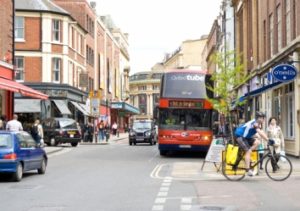Oxford LEZ brings air quality improvement
Early results suggest no exceedances of hourly NO2 limits since low emission zone introduced in January 2014
Early indications suggest that a low emission zone introduced in the centre of Oxford in January 2014 has had a significant impact on levels of nitrogen dioxide in the city.
Introduced earlier this year — the second in the UK outside London — the low emission zone (LEZ) has required the city’s bus fleets to be upgraded to meet Euro 5 emission standards. If bus companies do not comply, they face losing their licence to operate in the city.
The city council’s environmental policy team leader, Mai Jarvis, presented the latest city centre air quality monitoring data at the National Air Quality Conference in London yesterday (November 26), which showed that there have been no breaches of the hourly mean objective for nitrogen dioxide since the LEZ came into force (200 microgrammes per cubic metre).
This contrasts with more than 10 breaches of the hourly mean last year and nearly 60 breaches in 2012.
In addition, the data presented yesterday showed that measurements of annual mean nitrogen dioxide levels on both Oxford High Street and St Aldate’s street — both roads with historically high NO2 levels within the city’s LEZ — have also fallen this year.
St Aldate’s average more than 60 microgrammes per cubic metre (ug3) in 2011 and 2012, falling to under 55ug3 in 2013. Most recent figures show that since the introduction of the LEZ, this has dropped even further this year to below 50ug3.
Meanwhile, NO2 levels on the High Street have fallen from more than 55ug3 in 2013 to below 50ug3 this year.
The LEZ was developed in response to Oxford city council’s last Air Quality Action Plan (AQAP) in 2006. A new AQAP with provisions for an LEZ then followed after public consultation, which includes measures to tackle air pollution in the city up to 2020.
However, Mai Jarvis admitted there was still work to be done to improve air quality as current levels are still above the national nitrogen dioxide limit of 40ug3.
She told the conference: “We have monitored for over 20 years in Oxford and in 2001 we declared our first AQMA. We then extended this to cover the whole of the city — we thought it was important to try and tackle it in an integrated way.”
National Framework
With only a handful of LEZs in operation in the UK, calls have come from the likes of campaign group ClientEarth, the Labour Party and the Green Party for the government to develop a national framework to assist local authorities in developing their own LEZ proposals.
And, speaking at the conference airquaitynews.com yesterday, Mai Jarvis said she would “absolutely” support a national framework, which she believed would have helped in the development of Oxford’s LEZ.
She told the conference: “Each local authority is fighting our own little battles all the time. I would definitely like it if there was a national framework.”
South Oxfordshire council is also considering feasibility studies for a low emission zone as one of a number of proposals in its Air Quality Action Plan (see airqualitynews.com story).

















